by Andrew Watt, Kokkei Shimbun collector, 1997

Among the many attractive Japanese postcards published in the first decade of the 20th century, the Kokkei Shimbun postcards are for me the most exciting.
The satirical magazine Kokkei Shimbun was launched in 1901, and the postcards appeared as a separate publication, The World of Postcards (Bessatsu Ehagaki Sekai), from May 1907 through June 1909. Each month, 30 postcards were printed on postcard-thickness paper, and folded uncut into magazine-size pages — four to a page, except for the cover page which had a title design and only two postcards.
A wide variety of subjects is represented in the 780 postcards that make up the total. Most of the artists are unknown today.
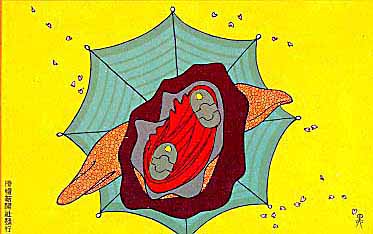
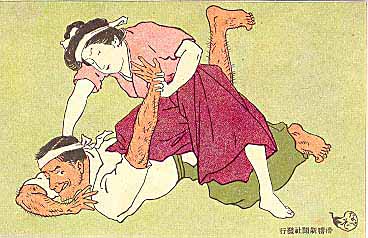
Right: Female judoka. Women were gradually taking a more active role in society, and this is reflected in a number of the cards.
Even with all three available to examine, understanding the meaning of some of the postcards today is a challenge, even for Japanese people. And in fact, it seems that even at the time they were published, the meaning remained obscure for some of their purchasers, since letters complaining about this were written to the publishers!
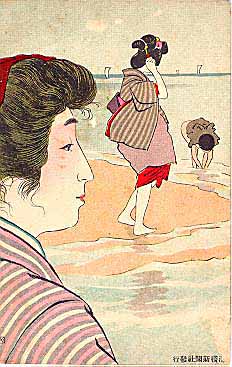
Many of the cards are humorous caricatures of the Japan of that time, some with raunchy subjects or graphic treatments that surprise people who think that the Japanese have no sense of humor. Others are more decorative, some viewing common scenes from an unusual angle, or with designs of flowers, fruit, or scenes of nature.
Almost all had a Japanese caption that was printed alongside the postcard on the original page. And almost all had a design on the back, in the square where the stamp is stuck. To understand the point or meaning of many of these postcards you need all three of these — in particular, the design at the back gives a hint to the point or joke in the main picture.
I have never been offered a complete set by a dealer, but individual cards cut from the original sheets come up from time to time in shops selling postcards, and at the fairs. I have never seen any at a flea market. They usually cost 1000-1500 yen, though cards by the much-collected artist Takahisa Yumeji will be 5000 yen or more. At the time of writing (September), Abeno in Kanda Jimbocho has a good selection in stock.
The dealers seem to charge the same amount regardless of whether or not the caption that appeared originally beside the card is included, and also regardless of the condition of the card. Usually the cards that appeared on the front or back of each month’s publication are in poorer condition than the cards that were inside.
At the time, the cards were almost all bought by Japanese, and today too most of the collectors are also Japanese. Foreigners visiting Japan at that time tended to buy the Japanese beauties or scenes that are well represented today in dealers’ trays at fairs in the US or Europe, and one doesn’t often see Kokkei Shimbun cards overseas.
However, since the 1992 exhibition of Philippe Barros’ collection of Japanese postcards at the Sogo Museum in Yokohama, and the publication of the catalogue (see below), many foreigners have also been attracted to these cards. In July this year, I saw some offered for sale at a fair in San Francisco.
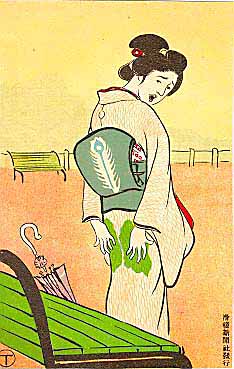
So far as I know, no book has been published showing, or even listing, all the cards. However, L’art des cartes postales — petites images oubliées de Meiji et Taisho, the catalogue of the exhibition mentioned above, illustrates 78 of them, and has a valuable explanatory text in French and Japanese that I have drawn on to write this article. The back illustrations, however, are not shown. It was published by Asahi Shimbun in 1992.
A wider selection of cards is illustrated in Kokkei Shimbun Bessatsu Ehagaki Sekai, edited by Akasegawa Genpei and Yoshino Takao, which also shows the back illustrations. It was published by Chikuma Shobo in 1985.
I hope this brief summary makes some of our readers interested in these wonderful cards. And if anyone has some they would like to sell, please contact me. I’m still searching!
Postcard Guide Contents
・Introduction
・Japan’s postcard history and how to date old postcards
・Gallery of vintage Japanese postcards – Philbert Ono Collection
・Japanese postcard FAQ – Includes postcard glossary
・Kokkei Shimbun postcards – by Andrew Watt
・Japan Times article on Postcard Club and founder Jason Smith – by Angela Jeffs in 1997
・Book review of postcard books – Meiji Period postcards
・Book review of Yokohama postcard book
・T. Enami – Yokohama-based photographer active in the 1920-30s
・Vintage Postcard Shops in Osaka
・Year Conversion Table – Figure out what year Meiji 5 was, etc.

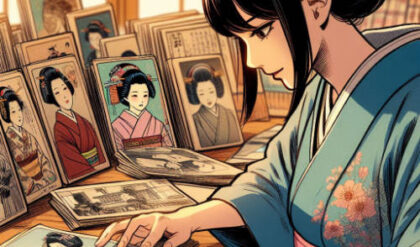

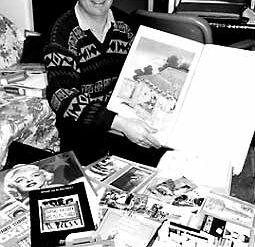
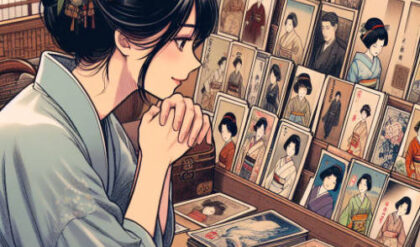
1 Comment